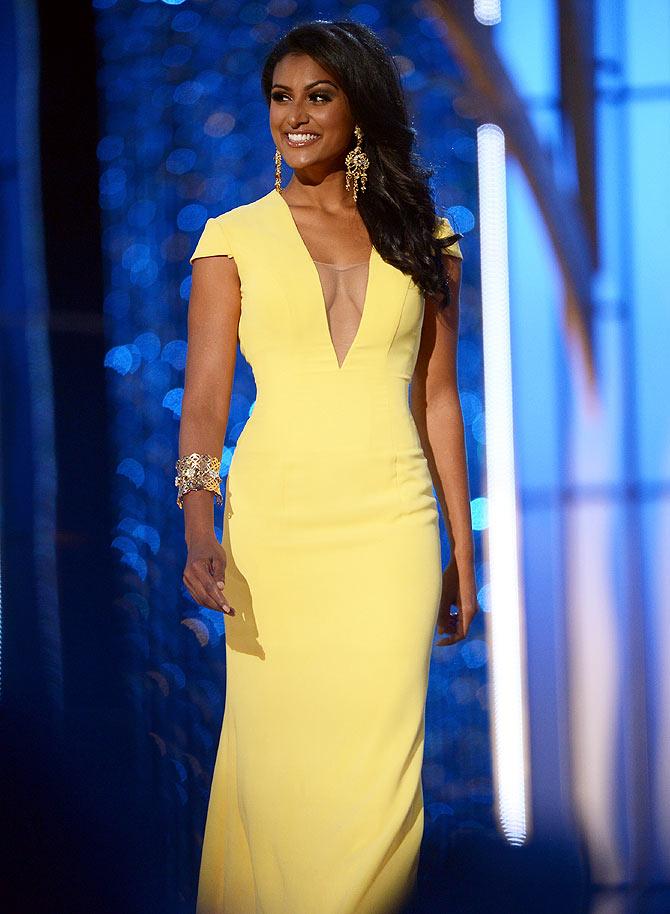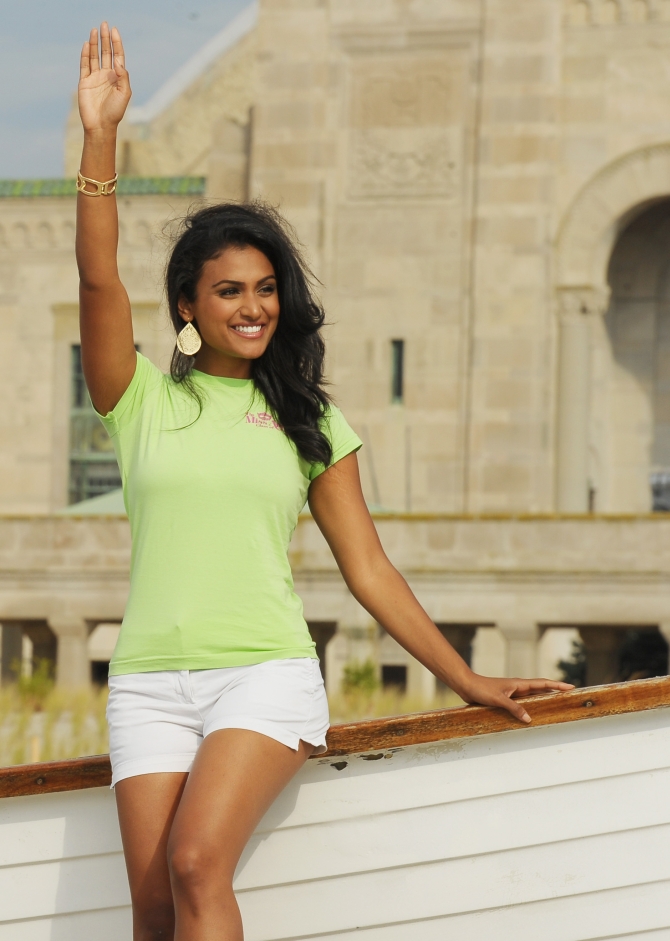Photographs: Michael Loccisano/Getty Images Amberish K Diwanji
Nina Davuluri's choice as Miss America shows how hollow Indians' concept of beauty is and how our beauty pageants don't reflect the country's diversity, says Amberish K Diwanji.
Nina Davuluri has won the Miss America title, and set off diverse reactions. Immediately after she was crowned, many Americans on Twitter bemoaned the fact that she was of Indian origin.
The tweets equated her with terrorism and the Arabs (the first is reprehensible, the second is just incorrect), and 7/11 (hmmm… true, many Indians do work in 7/11 stores, but then many are doctors and scientists, and IT guys and professors… the list is endless). Such tweets only reveal the ignorance of the average American, and that stereotyping people is something everyone does.
But some Indians and Indian-Americans have also noted that Nina would probably never win the award in India because she is dark skinned. . A Huffington Post article notes opinions that were voiced on Twitter, and there is some back and forth on the subject.
...
Unlike in USA, our beauty pageants don't reflect India's diversity
Image: Actor Shah Rukh Khan endorsing a fairness creamAmberish K Diwanji
Tragically, the article speaks the truth. And it doesn’t just stop at being dark-skinned but at how narrow the concept of beauty is in India. That one has to be fair to win a contest in India is almost a given, at best a girl can have a “wheatish” complexion. In fact, so averse are Indians to using the word 'dark', that, well, we don’t use it. Hence the ridiculous word “wheatish” (does anyone call fair people “riceish”?!?).
Every day Indians are bombarded with ads about fairness creams, an industry that is worth billions and growing. Even creams targeting typical teen problems such as acne and pimples advertise as fairness creams.
If that isn’t bad enough, what is worse is that some of India’s top stars endorse the same. Superstar Shah Rukh Khan promotes a “fairness cream specially made for men” (really?) and Kajol, once considered the most delightful dusky star India ever had, is endorsing some “fairness” cream as well. Alas!
…
Unlike in USA, our beauty pageants don't reflect India's diversity
Image: Nina takes a dip In the Atlantic Ocean after being crowned Miss America 2014 at Atlantic City Boardwalk HallPhotographs: Michael Loccisano/Getty Images Amberish K Diwanji
But skin colour is just one facet of Indian beauty contests’ narrow-mindedness. The other concern is the concept of “Indian” beauty that so dominates the choice of winners. India has been hosting such contests since 1947, and over the decades, we find similarity in the looks of all the winners.
Our winners are like plastic Barbie dolls, and that is not just a tragedy but also a shame. What makes it worse is that despite all the change our society has seen, this narrowness of the “Indian” definition of beauty hasn’t changed.
Most Indian beauty queens have chiselled looks, beautiful round eyes, sharp noses and a sharp jawline, and of course, a fair (very fair) complexion. Of course, one reason for this predilection is the kind of people taking part.
When Miss India contests were held in the 1950s and 1960s, it was the most “Westernised” Indians who took part -- Anglo-Indians, Parsis, girls from elite Hindu and Muslim families, and from northern India. Later, as more and more Indians began to take part, particularly girls whose fathers were in the armed forces (the armed forces anyway are India’s most westernised organisation), the winners came from more diverse backgrounds, but the concept of beauty remained unchanged.
This might explain why there are so many north Indian winners. This continued well into the 1970s and 1980s, though there were always some exceptions (a few south Indian women did win).
…
Unlike in USA, our beauty pageants don't reflect India's diversity
Image: Vanessa Williams was the first black Miss America in 1983Photographs: Danny Moloshok/Reuters Amberish K Diwanji
Not once has Miss India reflected the phenomenal diversity of this country. Never has a Dalit or a tribal woman won this contest, never a woman from northeast India (with pronounced Mongolian features) been chosen to represent India abroad.
Decades ago perhaps such women may have been too shy to take part, but that is hardly the case today. Northeastern girls are far more emancipated than women elsewhere in India. But the reason they don’t win, ever, is because they don’t have the traditional looks. The face as dished out by Amar Chitra Katha comics, of how our goddesses and apsaras (heavenly nymphs) might have (or should have) looked, or as decided by Raja Ravi Varma in his paintings.
In the US, a country with far less variety than India, the first black Miss America was Vanessa Williams in 1983 (she was later forced to give up her title after Penthouse published nude pictures of her).
Thirty years later, the US affirmed its commitment to diversity when Nina won the title. But in India, we remain wedded to our narrow notions of beauty.
Forget people from different backgrounds, we have yet to see a truly dark person or a northeastern person win. Obviously, those who judge our beauty contests still prefer people who buy fairness creams.





article